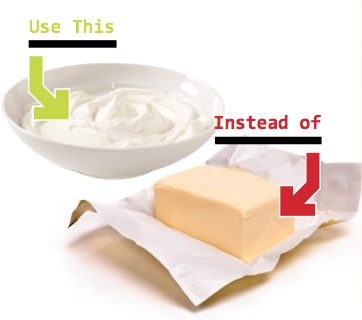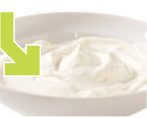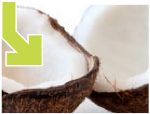

Some of my fondest childhood memories stem from spending hours in the kitchen with my Italian aunts and grandparents, baking sweet treats we would share on special occasions or just for dessert after Sunday dinner. At the time,there wasn’t much of a concern that the desserts we made were healthy; they just had to look and taste amazing.
Times have changed, and our society is becoming much more mindful of what we are eating. So much attention is being paid these days to ingredients and their origins. People are embracing different diets and nutritional lifestyles to determine which is best for them. Greater emphasis is being placed on keeping things fresh and steering away from processed foods. With our increasingly sedentary lifestyles and growing health concerns on the rise, such as obesity and food allergies, the demand for healthy alternatives has never been greater. The big contender for substitution is fat, and especially in desserts.
A while back, a friend was telling me how she added applesauce to her favorite brownie recipe in place of the oil… and loved it. She was thrilled because after years of trying fat-free products that were dry and not very flavorful, she had stumbled upon a solution that would satisfy her craving, without making her feel guilty. It turns out applesauce is just one of many fruit purees that work wonders in replacing the majority of, if not all, the fat in a baked good recipe. Purees, baby foods and even mashed fruits will keep a dessert rich and moist, without tasting the actual fruit or having it feel sticky to the touch. Bananas and peaches are good in chocolate cake recipes, while pureed pears work well for coffee cakes. Another benefit of adding fruit or vegetable puree is the addition of vitamins and minerals, therefore making it an even healthier treat. For the ratio of replacing the fat, start with half the amount of fruit as the butter or oil the recipe calls for. You can always add more if you notice your batter is dry.
There are several other worthy fat replacements available in your local grocery store. It is important to pay attention to the purpose the original fat serves in a recipe before you replace it, as baking is based on chemical reactions. Let’s take a look at some popular substitutes:
 Greek Yogurt
Greek Yogurt
This works great when added to boxed cake mixes to give them a more dense texture. By adding half the amount of the butter required in a cookie recipe (1 cup of butter would become 1⁄2 cup of butter and 1⁄4 cup Greek yogurt) you are reducing both the calories and saturated fat. Mashed avocado also works well in this respect.
 Coconut Oil
Coconut Oil
For years, coconut oil was compared to shortening and thought to be a “bad fat.” When purchased in its pure form, (not hydrogenated), coconut oil is actually a heart healthy food, as its saturated fat is plant-based. Similar to butter in that it can be creamed, this is an ingredient that will most likely be appearing more often in recipes and on store shelves.
 Nut butters
Nut butters
Think almond and hazelnut. Nut butter doesn’t have to be peanut! These “other” nut butters work nicely in most baked goods as well as in frostings for a subtle, nutty flavor and golden color.
 Beans
Beans
Using beans that are mashed or pureed will add a dense, fudge-like consistency to brownies and cookies, thus eliminating the need for oil. Butter beans or cannellini beans tend to work best.
 Eggs
Eggs
Eggs are a bit more difficult to replace as they are such a multifunctional ingredient. Primarily, they provide structure to a recipe and also help bind flour particles to the other ingredients. Soy yogurt or soy sour cream may offer results similar to eggs when using 1⁄4 cup in place of each egg. Tofu or silken tofu actually works well here, as it has properties good for binding and structural integrity. It can be purchased refrigerated or unrefrigerated, although the latter will have a less “beany” taste. Store-bought egg replacement products like Ener-G will also provide the leavening function of an egg to cake and cookie recipes, but may require a bit of water added for additional moisture.1
 Butter
Butter
It is usually not a good idea to substitute a light or diet version of butter or margarine as these contain more moisture and will result in a baked product that will not have as much volume and possibly a less desirable taste. In the case of substituting oil for margarine, or shortening in a cookie recipe, this will result in a greasier cookie and therefore is not recommended.
One of the most important rules in successful reduced or fat-free baking is to not over bake. These desserts require less time in the oven than those that are full in fat, so check them often. After serving, keep them fresh by storing them in airtight containers and refrigerate after 24 hours.
It may take trial and error, but with some practice, you should be able to create a dessert you can enjoy and be proud of. Whatever the reason to explore the many alternatives when enjoying baked goods, it is nice to know that taste and overall great quality do not have to take a backseat to a healthy lifestyle.
Resources and Further Reading:
1 “Baking with Alternative Ingredients”The Daring Kitchen- by Marika of
Madcap Cupcake. Retrieved from http://thedaringkitchen.com/food-talk/
baking-alternative-ingredients
“A Piece of Cake – Ideas from Wilton Baking Alternatives-Reducing Fat in your Favorite Baked Goods recipes” by Angie Thayer. retrieved from http://www.wilton.com/blog/index.php/baking-alternatives-reducing-fat-in-your- favorite-baked-goods-recipes/
“How to Use Fat Substitutes in Baked Goods” SheKnows How-To-by a SheKnows How-To Guide. retrieved from http://www.sheknows.com/how-to/articles/300093/how-to-use-fat-substitutes-in-baked-goods
